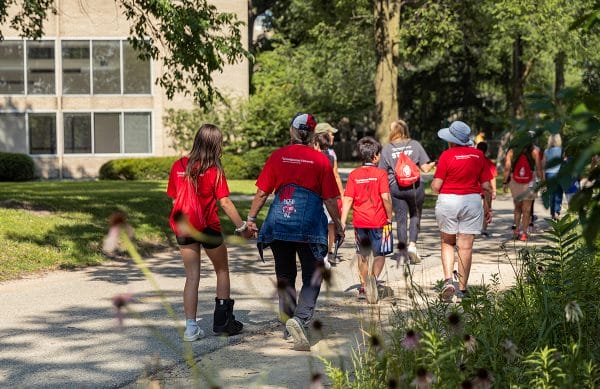Grandparents University
Honorary Degrees and Deep Connections
Students leave UW’s Grandparents University with a “credential,” some new knowledge and enthusiasm, and the enduring gift of quality time spent with loved ones. Courses at CALS make major contributions to the whole experience.
By Susan Lampert Smith BS’82
Jump to:
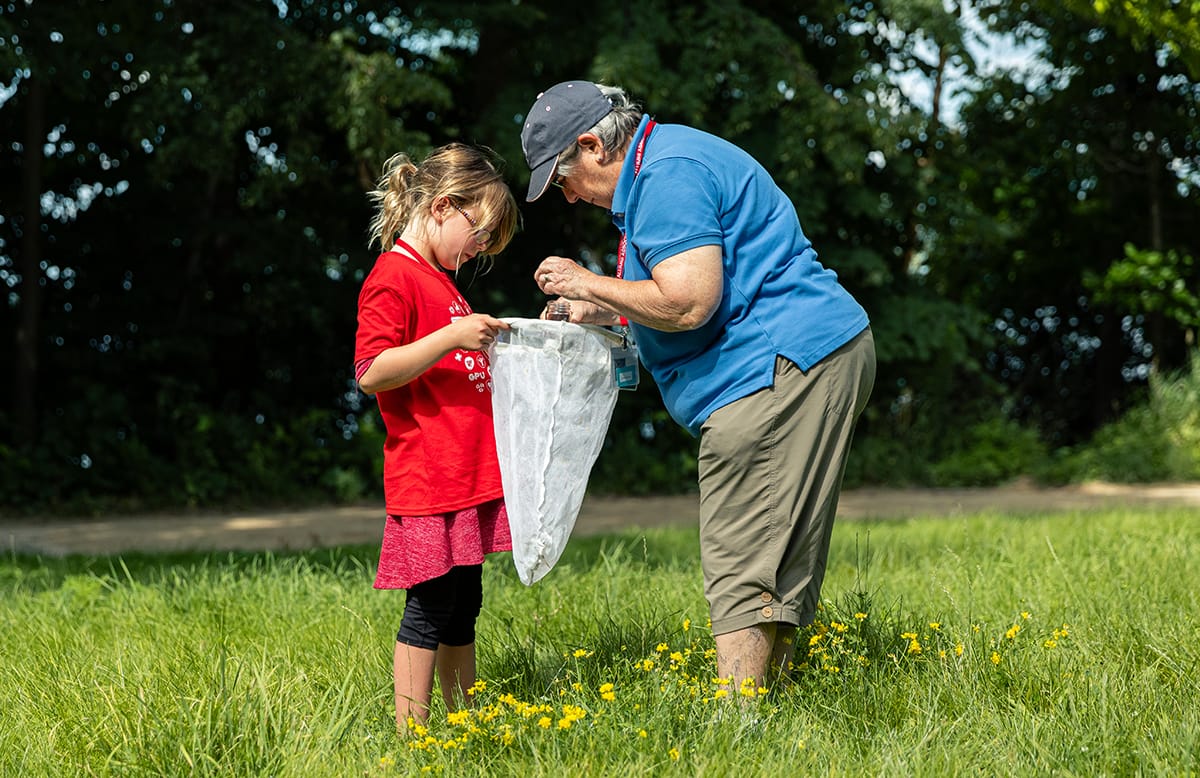

It’s like the ultimate sleepover with the grandparents: ice cream for breakfast, a behind-the-scenes tour of Camp Randall Stadium, and then an afternoon of bug hunting and animal tracking along the Lake Mendota shoreline.
Those are some of the actual activities offered at Grandparents University, which brings more than 1,300 children ages 7 to 14 and their grandparents to the UW campus every July to get a taste of college life and “major” in one of dozens of disciplines across campus — including at CALS.
Grandparents University (GPU) is as Wisconsin as Colby cheese. It began at UW in 2000 as a collaboration between the Wisconsin Alumni Association (WAA) and a University of Wisconsin–Extension program for grandparents raising their grandkids. But, says Kate Prehn, managing director of advancement programs at the Wisconsin Foundation and Alumni Association, the organizers quickly realized that many alumni would love to return to campus and share their love of all things UW with the grandchildren.
The program was an immediate hit, with sessions selling out in a matter of hours. It continues to be so popular that the WAA doesn’t even market it. The WAA has also trademarked the Grandparents University name and has helped start GPU programs on 26 other campuses, from Winona State to Purdue.


“It’s such a great opportunity to highlight the university’s outreach and share a love for higher education,” says Prehn, now in her 15th year with GPU. “Our participants will tell you that there’s something magical about the one-to-one intergenerational learning that happens at GPU. The kids feel they have a place on campus, and they get to spend quality time with their grandparents — without their parents!”
GPU is held on Thursdays and Fridays for three weeks in July. In addition to classes, every family group goes on one of a selection of campus tours, such as Camp Randall, Babcock Dairy, Lake Mendota (by boat), or the Memorial Union. The experience also includes a night out with Bucky Badger and ends with a graduation ceremony. And, while staying in campus housing is optional, many grandparents say their grandchildren’s favorite part of GPU is getting to choose their own food at Gordon Dining and Events Center, which serves the residence halls.
Bonnie Guest, a retired interior designer from Madison, has brought her grandchildren, Nolan and Olivia, to GPU for the past three years and says it has been a remarkable adventure of learning, amusement, and rare one-on-one time with the kids.
“It’s really fun to see their eyes open up to all these new things, the whole college experience,’’ Guest says. Olivia was enthralled by a tour of American Family Children’s Hospital, she says, and is hoping to get into the nursing course next year.
Over the years, GPU has grown from four majors to 30, Prehn says. Some of the most popular — probably because they entail making and eating ice cream and hot dogs or studying frogs and edible plants — are housed at CALS, including entomology, food science, meat science, nutritional sciences, and wildlife ecology.
The Joy of the Outdoors
Guest says she was surprised when Olivia selected wildlife ecology as her major in 2024, adding, “I’m not really a wildlife person, but it’s good to stretch.”


They both enjoyed the course, taught by Jamie Nack MS’02, an extension senior wildlife outreach specialist in the Department of Forest and Wildlife Ecology. Nack shows off the collection of taxidermy mounts at Russell Labs, demonstrates how to make a plaster cast of an animal paw, and leads a bird-watching excursion along the Lakeshore Path to see how many species of birds, mammals, and other critters they can identify.
Nack has been teaching for 20 years and welcomes children as young as 7 to take the class. (Some majors are limited to older children.) “Love of animals transcends age,” Nack says. “It’s a great opportunity to talk about human and wildlife interactions. And it’s really easy to feed off their joy.”
For some, taking Nack’s class has been truly life changing. Ben Schutt, now 24, remembers being a little kid who was completely gaga about animals. He would go to the library and check out every book he could find about them. He still remembers how excited he was when Nack showed him a taxidermy mount of a platypus.
“I had ADHD (attention-deficit/hyperactivity disorder),” Schutt says. “I was a wild kid. She did a super job of making me feel normal for being interested in all that stuff. She did such a good job of leaning into my strengths.”


Schutt says Nack’s class had such a pivotal impact on his life that he went on to earn a degree in wildlife ecology from UW–Stevens Point and kept in touch with Nack, later returning to GPU as a counselor.
Bug Safari
Barbara and Chet Gerlach, of Elkhart Lake, Wisconsin, have taken their five eldest grandchildren to GPU. In summer 2024, the opportunity fell to two of the younger ones, Charlie and Drew. Barbara Gerlach says they enjoy one-on-one time with the grandchildren; so, when Chet and Drew pursued the pharmacy major, Barbara and Charlie took to the field and lab with entomology graduate students Emma Terris BS’22, MS’24, Victoria Salerno, and Morgan Weissner BS’23.
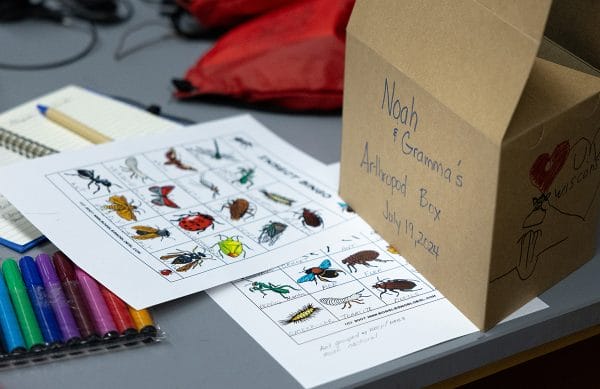

P.J. Liesch MS’10, extension entomologist and director of the UW Insect Diagnostic Lab at CALS, has been coordinating the GPU entomology major for 10 years, and, like Nack, enjoys welcoming the younger children in his classes because of their enthusiasm. He mixes up short lectures with participatory exercises, such as flapping their arms like an insect flaps its wings, playing “bug bingo,” and designing their own arthropods.
The class highlight is a bug safari. Kids and grandparents head to the Lake Mendota shoreline with nets and jars to build their insect collections. Someday, those collections may help paint an ecological picture of Madison at a specific moment in time.
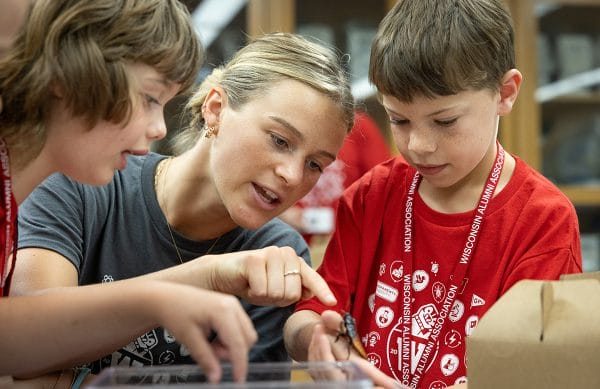

“I like to point out that we have the Wisconsin Insect Research Collection with millions of curated specimens, including some that were collected before Wisconsin was even a state,’’ Liesch says. “So, if you collect those specimens, and you properly prepare them and curate them and store them, someone could look at them 100 or 200 years later; there’s some really cool stories that can be told with that information.”
A Garden Graft of Art and Science
Tucked into a two-acre plot just a stone’s throw from Lake Mendota, Allen Centennial Garden blooms brightly in the summertime. It’s a public botanical garden, often called a “living laboratory,” that’s managed by staff in the Department of Plant and Agroecosystem Sciences (PAS). PAS is home to several CALS undergraduate majors, including horticulture, agronomy, and agroecology.


The garden is where Ryan Dostal and his staff welcome GPU students with a “taste your weeds” tour. They get to sample the lemony zing of wood sorrel and the pleasant crunch of purslane. The truly brave will bite on the orange and yellow eyeball-like flowers of a toothache plant and experience the numbing tingle of traditional medicine.
McKenzie Glynn-Zdrale, whose twin daughters Avy and Clover took this “SciArt” class in 2023, says it made a lasting impression on them. “My daughter Avy took to eating wood sorrel all the time,” Glynn-Zdrale says. “It was like her party trick, and she was proud of it. She was like, ‘I know this plant is safe, and you can put it in your salad at dinner.’ ”
She says the girls like to play in their backyard under a tree they call “the lab,” and they show their friends how to make watercolor paints and fabric dyes out of plants — skills they learned in SciArt. Their grandmother, Peggy Glynn, of Middleton, loved the class too, especially making the art projects from garden flowers. “It is the best bonding you can ever do,” Glynn says. “It’s not at your house, not at the parents’ house. You’re in a new environment, and the young people teaching the class are so great. It’s a fabulous place to showcase Wisconsin and Madison. The girls wanted to hug me afterwards.”
How the Sausage Gets Made
It’s as much a mystery as the old chicken and egg conundrum: How does a whole chicken become a chicken nugget?


The GPU meat science class, offered since 2019, teaches kids where some of their food comes from. After watching a video on how McDonald’s makes their McNuggets, the kids and seniors don safety gloves, get a lesson in knife skills, and learn how to break a whole chicken into more familiar cuts of meat.
“We picked poultry because it’s a really great model of the live animal-to consumer process,’’ says Jeff Sindelar, professor and extension meat specialist in the Department of Animal and Dairy Sciences. “We’re trying to work through that disconnect. You can transform something into a favorite food, and there’s a lot of gratification and fun in it. And everyone loves having fun.”


In 2024, GPU added a second meat sciences course, this one focused on making that other meat variety beloved by kids: hot dogs. Margaret Costello MS’24 helped plan the new class with fellow graduate students Sara Rodriguez and Jessica Brown.
“It’s fun to know where your food comes from,’’ Costello says. “For sausages, we show the ingredients, smell the different spices, and have them play ‘the ingredient game,’ where they try to identify the spices with the help of their grandparents.”They learn that hot dogs are full of spices: mustard powder, black pepper, sugar, marjoram, and nutmeg. On the first day, they make and taste fresh sausage patties in a Meat Science and Animal Biologics Discovery building lab that’s furnished with an oven and equipment to make small test batches of new products.
On “hot dog day,” kids and grandparents get to mix up the sausage “batter” and stuff it into casings, making long strands that are later cut apart and cooked.
Tom Lintner, a Milwaukee-based certified public accountant, took the hot dog class with his grandson, Dylan. “My grandson really enjoyed it and sampled all the hot dogs at the end,’’ Lintner says.
It also gave grandfather and grandson a chance to talk about the differences in their upbringings: Linter grew up with a clearer idea of where his food came from. “He’s a city kid; I grew up on a farm, and my best friend in high school was the son of a butcher,” Lintner adds.
Ice Cream Innovation
All the kids have access to the soft serve machine in the cafeteria during their time at GPU, but the really lucky ones get to make ice cream in class, and they get a chance to “work” at the Babcock Dairy Store.
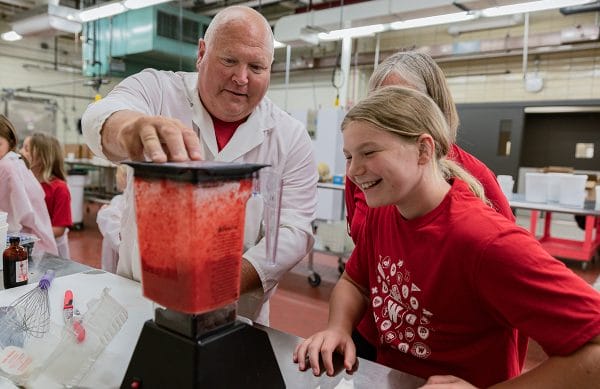

Scott Rankin, professor, chair, and extension specialist in the Department of Food Science, leads a class where kids and grandparents design their own ice cream flavor, make three gallons, and take pints home to share with their families. Rankin says the class often leads to cross-generational sharing, with grandparents reminiscing about old-fashioned flavors, such as sweet cream and butterscotch, that the kids might not be familiar with.
Each group can experiment with mixing flavors, swirls, and add-ins to invent and name a new ice cream. They get to try several versions and present the best one to the class. One group mixed maple syrup, waffle cones, and bacon to come up with “Sunday Morning Breakfast.”
“It’s fun to let them try different ideas within the matrix of ice cream,’’ Rankin says. “It’s hard to make a big mistake with ice cream. It’s about them making ice cream as grandparents and kids. It’s been a fun tradition, and we’re happy to be a part of it.”
In summer 2024, Carolyn and Dennis Kois of Pewaukee, Wisconsin, brought four of their grandchildren to the ice cream class, including siblings Bode, Amelia, and Morgan, and their cousin, Halas. The kids worked in groups of two and concocted four ice cream flavors: “Grandma’s House,” “Willy Wonka,” “Instagrammer,” and “Picasso.”
“The kids loved it, watching the process, getting to go to Babcock Hall, seeing the factory and working in the store,” Carolyn Kois says. “It was a good exposure for them, learning that ice cream doesn’t just appear in the grocery stores.”
Together, Dennis and Carolyn have 10 grandchildren — five of his and five of hers — and they’re all getting a chance to cycle through GPU. Dennis’s oldest grandson, Olin, is now a freshman at UW and mentioned Nack’s wildlife class when he applied. (Prehn, of WAA, says that prospective students often work GPU memories into their applications to UW.)


“It’s a priority of what they do in the summer, and they’re already talking about what they want to take next year,” Carolyn says. “It’s a neat bonding experience. I don’t live in the same town as my grandkids, so it’s special to have one-on-one time with them. Usually, we see them with a big gang of cousins.”
The Fate of Your Favorite Foods
Kids who took the GPU nutritional sciences class with Joe Pierre BS’08, PhD’12, assistant professor of nutritional sciences, can tell you what happens to those hot dogs, ice cream scoops, and chicken nuggets once they disappear down your gullet. After watching an episode of The Magic School Bus about digestion, the class builds a 22-foot replica of the human digestive system out of paper and yarn, stretching it down a hallway.
“It’s kind of mind-blowing to them how long it really is,’’ Pierre says.


Next, they take turns “feeding” the system with candies and wet newspaper, starting at the “mouth,” where one student spritzes it all with a spray bottle of “saliva.” Some kids move the “food” and water along the tract. Others assigned to the “small intestine” get to pull out the candy while those working the “colon” remove the wet newspapers.
Pierre keeps the class moving with different activities because the attention spans of his small students are much shorter than those of undergrads. With a solid understanding of the digestive system as a first-day foundation, the second day focuses on healthy food choices.
“I ask them what they had for breakfast,” Pierre says. “It’s surprising how many kids had ice cream — about half the class.”
After a short lecture on the history of vitamins and the basics of nutrients, kids and grandparents go outside to play a running game based on the five food groups. The grandparents spread out on the lawn holding signs that say “fruit,” “vegetable,” “protein,” “grain,” or “dairy.” Kids yell out their favorite food and then run to the sign for what they think is the matching category.
After that, they go back inside and consult with their grandparents on a mock grocery shopping exercise (again featuring their favorite foods) and draw a theoretical lunch on a paper plate.
“Pizza winds up on multiple plates,’’ Pierre says.
‘Commencement’
GPU winds down the same way college careers do for UW–Madison students, with a graduation ceremony — only this one is at Hamel Music Center rather than Camp Randall.
“They do a really good job of making you feel like you and your grandchild are number one,” Barbara Gerlach says.
“From the moment you arrive on campus, it’s just one big celebration after another. I always get teary eyed because I really love UW, and seeing my grandkids experience it is really magical.”
Grandparents University Registration
A grandparent or a parent must be a member of the Wisconsin Alumni Association (WAA) or one of the UW Foundation’s donor societies for a child to be eligible to participate in Grandparents University (GPU). However, you don’t have to be the grandparent of the participating child to take part: Aunts, uncles, and even neighbors and friends have taken children to GPU.
GPU is so popular that many sessions fill up almost immediately, so it’s good to consult with grandchildren about top major choices ahead of time and be sure you’re eligible. See registration timelines and other details at uwalumni.com/grandparents-university.
